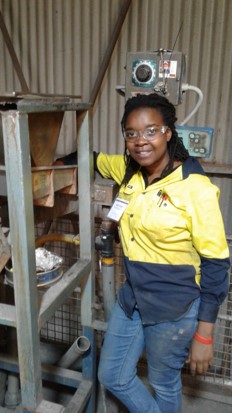Ndagha P Mkandawire
CFD-DEM Modelling of Dense Medium Cyclones
|
CRC ORE |
Program 3: Extract (P3-008) |
ORE |
|
|
|
PhD Topic: |
CFD-DEM Modelling of Dense Medium Cyclones |
|||
|
Institution: |
Curtin University |
|||
|
Research |
Prof Jacques Eksteen |
|||
|
Expected |
March 2020 |
|
Meet Ndagha Patience Mkandawire: |
||
|
|
ORE |
Ndagha Mkandawire has a background in mechanical engineering, and mineral processing and extractive metallurgy. She is currently completing a doctor of philosophy research degree in mining and metallurgy where she is working on developing a model for gold ore preconcentration in a dense medium cyclone using computational fluid dynamics (CFD) and discrete element method (DEM). Ndagha completed her Master of Engineering Science degree in 2016 where her research topic focused on integrating conventional flotation and electroflotation to possibly improve the floatability of fine and ultrafine particles. Ndagha hopes to continue to work in the minerals sector, especially in research and product development/improvement and to continue to develop her mathematical modelling and scientific data analysis skills after her PhD. |
|
Focus area: |
||
|
A CFD-DEM Model for Gold Ore Preconcentration in a Dense Media Cyclone.
|
Computational Fluid Dynamics (CFD) coupled with Discrete Element Method (CFD-DEM) have been of ultimate importance for the modelling of particle-particle and particle-fluid interactions with typical applications in the modelling of the Dense Medium Cyclone (DMC) and fluidised beds. CFD-DEM modelling is used as a cost effective tool for modelling compared to carrying out a large number of laboratory and pilot experiments for determining machine and operating conditions best suitable for a given process. The study will explore the potential of using the DMC for preconcentrating various types of gold ores and predicting machine and operating conditions for a given type of ore. The project uses CFD-DEM simulations in order to improve existing empirical models used for determining ore separability in a DMC. The developed model/s will be verified and validated using experimental data and existing DMC empirical modelling methods. The focus is on gold ores due to their wide variations in ore characterisation. This includes their density distribution across the ore size distribution, which makes separation complex compared to, for example, coal beneficiation.
|
|
![]()
![]()
![]()

